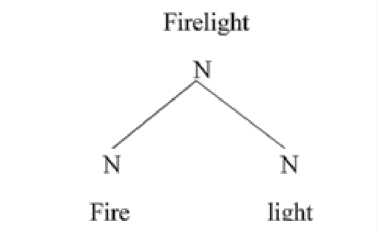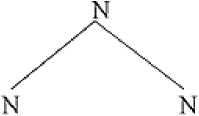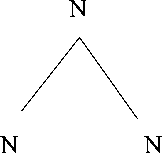Compound Word in Harry Potter’s Novel “The Goblet of Fire”
on
DOI: https://doi.org/10.24843/JH.2020.v24.i04.p04
Terakreditasi Sinta-4, SK No: 23/E/KPT/2019
p-ISSN: 2528-5076, e-ISSN: 2302-920X
Humanis
Vol 24.4 Nopember 2020: 372-378
Compound Word in Harry Potter Novel The Goblet Of Fire
Putu Feby Chintya Dewi*, I Nyoman Sedeng, Ketut Santi Indriani English Department, Faculty of Arts, Udayana University [febychintyadewi@gmail.com], [nyoman_sedeng@unud.ac.id], [kt.santi.indriani@gmail.com]
Denpasar, Bali, Indonesia *Corresponding Author
Abstract
This study is aimed at analyzing types and meanings of the compound words in Harry Potter’s: Goblet of Fire. The data were taken using documentation method and note-taking technique. Qualitative method was applied to analyze the data. The theory that was used in identifying the types of compound words is the theory of compound proposed by Lieber (2009). The results showed that there are three types of compound words found in the Harry Potter’s Novel, they are; attributive compound, coordinative compound, and subordinative compound. Based on the second problem, about the analysis of meaning, most of compound words has the general meaning or meaning just like in the dictionary, on the other hand a few compound words are constructed differently in Harry Potter’s novel.
Keywords: compound words, novel, meaning.
Abstrak
Studi yang berjudul “Compound Word in Harry Potter’s Novel the Goblet of Fire” ditunjukan untuk menganalisis tipe dan makna dari kata majemuk. Data ini diambil menggunakan metode dokumentasi dan teknik pengambilan catatan. Metode qualitative diterapkan untuk menganalisis data. Teori yang digunakan dalam mengidentifikasi jenis kata majemuk adalah teori senyawa yang diusulkan oleh Lieber (2009). Hasil ini menunjukan bahwa ada tiga jenis kata majemuk yang ditemukan dalam novel Harry Potter, yakni: senyawa atributif, senyawa koordinatif, dan senyawa subordinatif. Berdasarkan masalah kedua, tentang analisis makna, sebagian besar kata majemuk memiliki makna atau makna umum seperti pada kamus, di sisi lain beberapa kata majemuk dibangun secara berbeda dalam novel Harry Potter.
Kata kunci: kata majemuk, novel, makna
INTRODUCTION
Morphology is a linguistic branch that discusses word formation on the use and construction within an utterance context, (Sidupa, 2015). It studies about how the words are built up from the smallest pieces (Rahayu, 2016). It is a study that focuses on how words are formed or constructed. In morphology, there is a process which is called morphological process that plays the most important role to create a new word
(Yanti, 2018). Many languages can form words with a process called compounding. A word itself has a meaning which can be grammatically simple and complex. The simple word is the smallest word only consisting of one single morpheme that has a meaning. While, complex word is word that has internal structure that can be derived into smaller part, while the simple word is the smallest word only consisting of one single morpheme that has a meaning, (Rumiyanti,
372
Info Article
Received : 27th November 2019
Accepted : 2nd November 2020
Published : 30th November 2020
2015). Compound words are words consisting of two or (more) base, roots, and stems. (Lieber, 2009: 43). Compounding has been at the center of interest years and several aspects, compounding as a universal process has been a controversial issue, (Ralli, 2013). Many of the new terms are formed by combining two or more existing words to create new meaning, (Indarto, 2015). Compound word consists of addition of stem in which a word is formed by the combination of two independent words, (Wibowo, 2014). Compounding is also notable for its great productivity, (Séaghdha, 2008). Many new words are formed from compound words. The creations of compound words depend on the creativity that language users have chosen. (Turangan, 2017). In arrange to induce understanding approximately the subject, there are a few past ponders almost morphology, word arrangement, and compound words and those were portrayed and considered having connection to this consider, (Noumianty, 2016). One of those interesting aspects is morphology as it observes the word formation which includes the ways new words are coined in the languages of the world, (Budiarta, 2016). The data were collected by using documentation method, then analyzed the data using qualitative method, and present the analysis by using formal and informal method, (Isnaini, 2019; Angga, 2018; Deleger, 2009).
MATERIAL AND METHOD
The data of this research was taken from Harry Potter Novel The Goblet of Fire. Harry Potter is a series of fantasy novels written by British Author J.K Rowling. The book was released on 8 July 2000. Goblet of Fire was the first book of the Harry Potter series released in the US. The novel has 734 pages. The novel tells the story of a tournament held by the Hogwarts School of magic that hosts by inviting two other schools to tighten the fraternity between these three schools, but at the end of the story one of the participants who came from Hogwarts School of magic died that is Cedric, who was a friend of Harry Potter. The book gained great attention after there was a pre-publication leak from Rowling saying that one of the figures would
be killed in the book. The reason of choosing this novel as the data, because this novel is a great popular. This novel has a considerable reader. Beside that this novel also has many compound words and the writer really likes to play words and combine them into new words. The method of collecting data in this study was documentation method. There are several kind of technique in documentation such as, note taking, capturing picture, and recording. Note taking is suitable for this kind of research because the data is in a form of a novel.
The data were collected by using documentation method, then analyzed the data using qualitative method, and present the analysis by using formal and informal method.
THEORETICAL BASIS
Literature Riview
There are jurnal articles that has been riviewed are related to compound words. Morphology is learning about morpheme and morpheme is the element of language that have meaning and also support the meaning, (Yusuf, 2017; Haryati, 2014). Compound words are one of the elements found in the field of morphology, (Ihsan, 2019). In English, when the compound word builds up, not only the types of compound words which are varied but also their meanings, it might have confused people who are not native speaker. Language also has meaning. Language makes people understand each statement, (Nur, 2016). Language is a tool of communication to send ideas, feeling, and message, (Cahyanti, 2016; Rosa, 2012).
In linguistic it is a processof word formation that is very productive in which two or more words are combined into a new word, (Sari, 2013). Compounding is one of the processes in language formation, (Hadiati, 2011). Compound words employed a productive role in this language, (Fan, 2014). This study was relevant to be reviewed in order to give a better understanding about concept of compound word, since it also explained
about categorization of compound words, which was related with the first problem.
RESULT AND DISCUSSION
In compound words, there some ways to identify a compound word such as: first, the stress pattern of the compound word is usually different from the stress pattern in the phrase composed of the same words in the same order. It means that the main stress of in the phrase is on the last word. While this pattern does not apply to all compounds, it is so generally true that it provides a very useful test. The first discussion in this data is classifying the types of compound words found in Harry Potter’s Novel. There are three types of compound words in Lieber (2009) theory such as:
Attributive Compound
In attributive compound the non-head acts as a head modifier in an attributive compound.
Data 1.
The usual large amount of beads, chains, and bangles glittered upon her person in the firelight.
Compound firelight is formed by two words including fire and light. They are free morphemes that belong to the same word category that is noun, and they can stand alone as a word. The construction of the compound is shown by tree diagram below:

Furthermore, the word firelight is defined as the attributive compound because the first element could express just about any relationship with the head or the second element. The word fire as the non-head of this attributive modifies the word light as the head.
The word firelight could also be included in endocentric variation because in endocentric, the referent of the compound is the same as the referent of the head. Therefore, firelight is a kind of light.
Semantically, the meaning of the compound can be interpreted by identifying the modification done by non-head towards the head. Non-head fire modifies the meaning of light. The relationship lying between those two is that fire is the source of the light. Thus, the compound firelight means the light of a fire.
Data 2.
Crouch being an important Ministry member, he and his wife were allowed a deathbed visit
Compound deathbed is formed by two words including death and bed. They are free morphemes that belong to the same word category that is noun, and they can stand alone as a word. The construction of the compound is shown by tree diagram below:
deathbed

death bed
Furthermore, the word deathbed is defined as the attributive compound because the first element could express just about any relationship with the head or the second element. The word death as the non-head of this attributive modifies the word bed as the head.
The word deathbed could also be included in endocentric variation because in endocentric, the referent of the compound is the same as the referent of the head. Therefore, deathbed is a kind of bed.
Semantically, the meaning of the compound can be interpreted by identifying the modification done by non-head towards the head. Non-head death modifies the meaning of bed. The relationship lying between those two is that death is the source
of the bed. Thus, the compound deathbed means a bed on which dead person lies.
Coordinative Compound
The first element of the compound does not alter the second in coordinative compounds; instead, the two have equal weight.
Data 1.
Harry stared out of the window at the inky blue-black sky.
Compound blue-black is formed by two words including blue and black. They are free morphemes that belong to the same word category that is adjective, and they can stand alone as a word. The construction of the compound is shown by tree diagram below:
Blue-black
ADJ

ADJ ADJ
blue black
Furthermore, the word blue-black is defined as the coordinative compound because the first element stands equally with the second element. The word blue-black could also be included in endocentric variation because in endocentric, the referent of the compound is the same as the referent of the head. Therefore, blue-black is a kind of black.
Semantically, the meaning of the compound blue-black can be interpreted by identifying the meaning of both elements. As both elements have equal weight in meaning, this compound blue-black means the combination of color blue and black.
Data 2.
“That sort of behavior seriously undermines wizard–Muggle relations!
Compound wizard–Muggle is formed by two words including wizard and muggle. They are free morphemes that appertain to the same word category that is adjective, and
they can stand alone as a word. The construction of the compound is shown by tree diagram below:
Wizard-muggle
N
N N
wizard muggle
Besides, the word wizard–Muggle is defined as the coordinative compound because the first element stands equally with the second element. The word wizard– Muggle could be included in exocentric when the referent of the compound as a whole is not the referent of the head. Thus, wizardmuggle is equally a wizard and a muggle.
Semantically, the meaning of the compound wizard-muggle can be interpreted by relate the meaning of both elements. As both elements have equal weight in meaning, this compound wizard-muggle means the equally a wizard and a muggle.
Subordinative Compound
One element is interpreted as the argument of the other in subordinative compounds, usually as its object. Subordinative compounds are interpreted in a very specific way; that is, the first element of the compound is interpreted as the object of the verb that forms the basis of the de-verbal noun.
Data 1.
Hate mail continued to arrive for Hermione over the following week, and although she followed Hagrid’s advice and stopped opening it, several of her ill-wishers sent Howlers.
Compound ill-wishers is formed by two words including ill and wishers. They are free morphemes belonging to the same word category that is noun, and they can stand alone as a word. The construction of the compound is shown by tree diagram below:
Ill-wishers
N

N N
ill wishers
Furthermore, the word ill-wishers are defined as a subordinative compound because the non-head element acts as the argument of the head. The word ill as the non-head of this subordinative acts as the object of the word wishers as the head.
The word ill-wishers could also be included in endocentric variation because in endocentric, the referent of the compound is the same as the referent of the head. Therefore, ill-wishers is a kind of wisher.
Semantically, the meaning of the compound can be interpreted by identifying what kind of argument the non-head is. Nonhead ill is the object of wishers. The relationship lying between those two is that ill is what the wishers want to happen. Thus, the compound ill-wishers mean a group of wisher that want ill to happen to someone.
Data 2.
Harry had always imagined Bill to be an older version of Percy: fussy about rulebreaking and fond of bossing everyone around
Compound rule-breaking is formed by two words including rule and breaking. They are free morphemes belonging to the same word category that is noun, and they can stand alone as a word. The construction of the compound is shown by tree diagram below:
Rule-breaking

Rule breaking
Furthermore, the word rule-breaking is defined as a subordinative compound because the non-head element acts as the argument of the head. The word rule as the non-head of this subordinative acts as the object of the word breaking as the head.
The word rule-breaking could also be included in endocentric variation because in endocentric, the referent of the compound is the same as the referent of the head. Therefore, rule-breaking is a kind of breaking.
Semantically, the meaning of the compound can be interpreted by identifying what kind of argument the non-head is. Nonhead rule is the object of breaking. The relationship lying between those two is that rule is what the breaking want to happen. Thus, the compound rule-breaking means a rule-breaking that someone wants to do.
CONCLUSION
Based on the fore going discussions it can be concluded that there are three types of compound word found in Harry Potter Novel which are attributive compound, coordinative compound and subordinative compound. Based on the research attributive compound found are ten words. Meanwhile, in coordinative compound found are ten word, and for the subordinative compound that found ten words. Then, it is followed by the type of compound that often occurred in the data of HarryPotter’s Novel because there are many English compound words of which the elements come from Lieber (2009).
REFERENCES
Angga, I.M.Y.D (2018). Compound Word Formation in “The Old Man and The Sea”. Humanis. Vol. 22, No. 2. 2018
Budiarta, I.W. (2016). Compound Word in Dawan Language. Ilmu Bahasa. Vol. 2, No. 1 April 2016, 1-15
Cahyanti, R.D. (2016). Compound Words Used in Stephenie Mayer’s Twilight. Journal on English as a
Foreign Language. Vol. 6. No.1 March 2016.
Deleger, L. (2008). Morphosemantic parsing of medical compound words: Transferring a French
analyzer to English. International Jurnal. Vol. 78: 48-55
Fan. C. (2014). Cognitive Analysis Of Exocentric Verb-Noun Compound in English. International Journal. Vol. 3. No, 2: 176-189
Hadiati, C. (2011). A Morphological Analysis of English Compound Words In Tolstoy’s God Sees The Truth, But Waits. Lensa. Vol. 1. No. 2. 2011
Haryati, C. (2014). A Study of Word Formation Process of Food And Beverage Product Names In Indonesia. Vol. 2. No.2. 2014
Ihsan, R.F. (2019). Analysis Of The English Open Compound Words. Jurnal JIPS. Vol. 3. No. 1. 2019
Indarto, J.A. (2015). Compound Nouns In Computer Software Technical Terms. Vol. 15. No. 01 Mei 2015
Isnaini, R. I. 2019. Compound Word in ‘The Great Gatsby Novel’ Written by Fitzgerald. 2019
Lieber, R. (2009). Introducing Morphology. University of New Hampire
Nur. N.H. (2016). An Analysis of English Compound Words in Daily Vocabulary Book. 2016
Noumiyanti, D.S. (2016). An Analysis of Compound Words on Culinary
Terms in MasterCheff U.S. Season 7 (2016). 2016
Rahayu, K.S.D. (2016). A Morphological Analysis on English Compound Words in Five Article of BBC News. Artikel Ilmiah Mahasiswa. 2016
Rally, A. (2013). Compounding and Its Locus of Realization: Evidence from Greek and Turkish. Word Structure. 6.2 (2013): 180-200
Rumiyant, A. (2015). A Morphological Analysis of Compound Words Used in Novel “The Single Girl’s TO-DO- List” by Lindsey Kelk. Publication Article. 2015
Rosa, R.N. (2012). An Analysis Of Word Formation Used In Twilight Novel By Stephenie Meyer And Twilight Movie Script Written By Melissa Rosenberg. Vol. 1. No.1. 2012
Sari, R. (2013). Compound In Information Technology Terms: A Morphological Study. Vol. 13. No. 1. 2013
Sidupa, J.N. (2015). Compound Word Formation in Matilda. Humanis. Vol 11. No. 2 Mei 2015
Séaghdha, D. O. (2008). Learning Compound Noun Semantic. University of Cambridge, Corpus Christi Collage
Turangan, K.A. (2017). Compound Word in BBC New Website. Humanis. Vol 18.2 Pebruari 2017: 153-160
Wibowo, A.A. (2014). A Morphological Study on English Compound
Words Found in Handbook of
Psycholinguistics Subject at 7th
Semester at Muhammadiyah University of Surakarta. Article Publication. 2014
Yanti. N.K.M. (2018). Types and Meaning of Compound Words Found in Medical Textbook Entitled Gray’s Basic Anatomy. Humanis. Vol 22.4 November 2018:1099-1103
Discussion and feedback